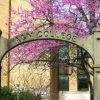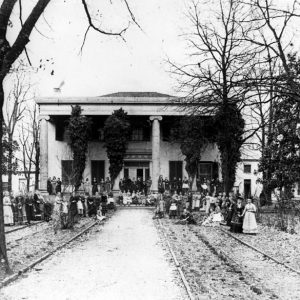calsfoundation@cals.org
Arkansas Female College
Arkansas Female College operated in Little Rock (Pulaski County) from 1874 to 1897, first in what is now the Pike-Fletcher-Terry House and then in a new facility at Fourteenth and Rock Streets.
In an effort to establish a first-class school for female students—originally called State Female College at Little Rock—a group of prominent Arkansas men formed a board and had registered as a corporation under the laws of Arkansas by September 1, 1871. Half of the board’s fundraising goal of $40,000 was raised (by subscription) by 1872 and the rest by 1873. William Ratcliff was named secretary and was to handle subscriptions. Future Arkansas governor Augustus Hill Garland was named president, while John J. McAlmont and nine others formed the board. Three conferences of the Methodist Episcopal Church, South—White River, Little Rock, and Arkansas—had agreed to cooperate with the board. By 1872, the name had been shortened to Arkansas Female College (AFC) and a committee had been named to look for a location to build the college. The Reverend Augustus R. Winfield was named as agent.
Before he started on a tour of the state seeking funds, Winfield wrote a long list of the advantages of having a female college in Little Rock, including the city’s beauty, the fact that young ladies could to be closer to their mothers, and the fact that Little Rock already had a male college (St. Johns’ College). Although her name did not make the newspapers at first, the driving force behind the AFC was Myra Cornelia McAlmont Warner. The sister of board member John McAlmont, she was an experienced educator and had begun conducting a school in Little Rock after the Civil War. By 1873, the decision had been made to rent the Albert Pike home from Pike’s daughter to operate the AFC.
In 1839, Pike purchased twelve lots comprising one full block on Seventh Street in Little Rock and began construction of his home, a two-story house in the Greek Revival style with six large columns across the front. There were eight rooms, four on each floor, with a central hall on each floor. Pike had moved to Washington DC by 1873, but his daughter Lillian Pike was taking care of the property. In August 1873, the board of directors of Arkansas Female College leased the house and grounds from Lillian Pike, to whom Albert Pike had deeded his interest in the property in 1871. By the summer of 1874, everything was nearing readiness, and the AFC opened for its first school year on October 5, 1874, in the Pike Mansion (now known as the Pike-Fletcher-Terry House).
General Levin M. Lewis was president of the college; he was a former Confederate general and had been president of a school in Missouri. Myra Warner was primary principal. On December 23, 1874, the AFC opened its doors for a public program. There were about seventy young women in the college, and the eighteen students in the musical department presented the program. One of the students presenting was fourteen-year-old Julia Warner, daughter of Myra Warner. Julia continued her education at the AFC, graduated, and became a member of the faculty by age seventeen. The college closed for the winter break and resumed school on January 4, 1875.
The building was soon expanded, the new construction being described in the Second Annual Catalogue of the Arkansas Female College for the collegiate year ending on June 7, 1876, as a “two-story addition eighty feet long by thirty-five feet wide, containing a large study hall, recitation room, and dormitories.”
General Lewis retired due to illness in May 1878, and the Reverend Andrew Hunter was named president, with Myra Warner to continue as principal. Although the college was well attended and popular with the public, funds were sometimes hard to obtain. The school was able to celebrate ten years of operation in 1884 with increasing enrollments, however.
In 1886, Lou Krause, a member of the teaching staff, purchased the Pike Mansion and assumed the position of principal of the AFC. She made necessary repairs and converted some of the rooms to small music practice rooms with only a piano, three chairs, and a stove. On the second floor, the large rooms used for boarding were converted to rooms that held only two students each. At this time, with sixty students enrolled, Myra Warner was director of the collegiate department and Julia Warner was in charge of the preparatory department.
In July 1889, Myra Warner announced that the AFC would open for the sixteenth annual session in buildings being erected at Fourteenth and Rock Streets. The college opened in September 1889 in the newly erected facility at 1400 Rock Street, operating in this facility until after commencement in 1897. It was then announced that due to the long-term illness of Warner, school would be suspended. The AFC never reopened.
For additional information:
“Arkansas Female College.” Arkansas Democrat, August 23, 1884, p. 5.
“Arkansas Female College.” Arkansas Democrat, July 24, 1889, p. 3.
“Arkansas Female College.” Arkansas Gazette, May 3, 1878, p. 4.
Arkansas Female College collection, 1875–1948, Arkansas State Archives, Little Rock, Arkansas.
“Educational.” Arkansas Gazette, September 1, 1871, p. 4.
“The Female College.” Arkansas Democrat, October 1, 1884, p. 3.
“The Female College.” Arkansas Gazette, February 21, 1873, p. 4.
“The Ouachita College.” Arkansas Democrat, July 24, 1889, p. 3.
“Musical Soiree.” Arkansas Gazette, December 24, 1874, p. 4.
Roy, F. Hampton, Sr., Charles Witsell Jr., with Cheryl Griffith Nichols. How We Lived: Little Rock as an American City. Little Rock: August House, 1984.
Carolyn Yancey Kent
Jacksonville, Arkansas









Comments
No comments on this entry yet.